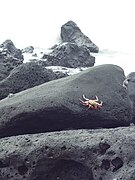Tortuga Bay
Tortuga Bay is located on the Santa Cruz Island, about a 20-minute walk from the main water taxi dock in Puerto Ayora. The walking path is 1.55 miles (2,490 m) and is open from six in the morning to six in the evening. Visitors must sign in and out at the start of the path with the Galapagos Park Service office. Tortuga Bay has a gigantic, perfectly preserved beach that is forbidden to swimmers and is preserved for the wildlife where many marine iguanas, galapagos crabs and birds are seen dotted along the volcanic rocks. There is a separate cove where you can swim where it is common to view white tip reef sharks[1] swimming in groups & on occasion tiger sharks [2][3] The genus, Galeocerdo, is derived from the Greek galeos, which means shark, and the Latin cerdus, the word for the hard hairs of pigs.[3] It is often colloquially called the man-eater shark.[3]the Galapagos shark [4][5] atop other species of sharks that are found in the Galapagos Islands. There are always a large variety of small fish, birds, and gigantic galápagos tortoise.The Galápagos Islands were discovered in 1535, but first appeared on the maps, of Gerardus Mercator and Abraham Ortelius, in about 1570.[6] The islands were named "Insulae de los Galopegos" (Islands of the Tortoises) in reference to the giant tortoises found there.[7][8][nb 1]
Gallery
-
Start of the Walking path to Tortuga Bay
-
Walking path to Tortuga Bay (almost at the beach)
-
Finish line of the Walking path to Tortuga Bay (at the beach)
-
The beach at Tortuga Bay
-
A Marine Iguana walking on the beach at Tortuga Bay
-
Birds and Volcanic Rocks at Tortuga Bay
-
Volcanic Rocks at Tortuga Bay
-
Volcanic Rocks & Grapsus grapsus Galapagos crabs (Tortuga Bay)
See also
Notes
- ↑ The first navigation chart showing the individual islands was drawn up by the pirate Ambrose Cowley in 1684. He named them after fellow pirates or English noblemen. More recently, the Ecuadorian government gave most of the islands Spanish names. While the Spanish names are official, many researchers continue to use the older English names, particularly as those were the names used when Darwin visited. This article uses the Spanish island names.
References
| Wikimedia Commons has media related to Tortuga Bay. |
- Galapagos Nacional Park, Tortuga Bay http://www.galapagospark.org/sitio.php?page=bahia_tortuga ecuador-travel.net
- Tortuga Bay, Galapagos http://www.ecuador-travel.net/galapagos.site.tortugabay.htm
- Galapagos Nacional Park on galapagos.org http://www.galapagos.org
- ↑ Compagno, L.J.V. (1984). Sharks of the World: An Annotated and Illustrated Catalogue of Shark Species Known to Date. Rome: Food and Agricultural Organization. pp. 535–538. ISBN 92-5-101384-5.
- ↑ "Items Found in the Stomachs of Tiger Sharks". Finformation. Retrieved 2013-08-29.
- ↑ 3.0 3.1 3.2 Knickle, Craig. "Tiger Shark Biological Profile". Florida Museum of Natural History Icthyology Department. Retrieved July 2011.
- ↑ Snodgrass, R.E. and Heller, E. (January 31, 1905). "Papers from the Hopkins-Stanford Galapagos Expedition, 1898–1899. XVII. Shore fishes of the Revillagigedo, Clipperton, Cocos and Galapagos Islands.". Proceedings of the Washington Academy of Science 6: 333–427.
- ↑ Bester, C. Biological Profiles: Galapagos Shark. Florida Museum of Natural History Ichthyology Department. Retrieved on April 26, 2009.
- ↑ Stewart, P.D. (2006). Galápagos: the islands that changed the world. New Haven: Yale University Press. p. 43. ISBN 978-0-300-12230-5.
- ↑ Pritchard 1996, p. 17
- ↑ Jackson, Michael Hume (1993). Galápagos, a natural history. Calgary: University of Calgary Press. p. 1. ISBN 1-895176-07-7.







